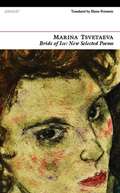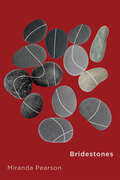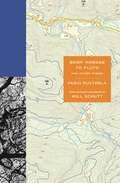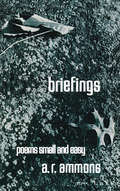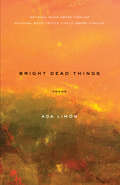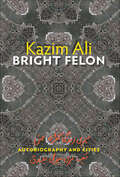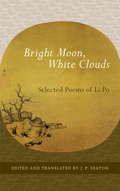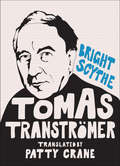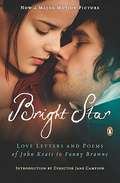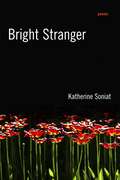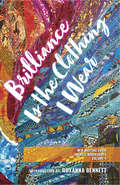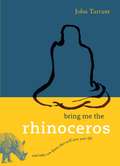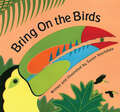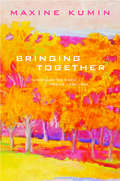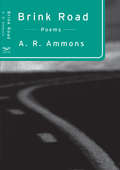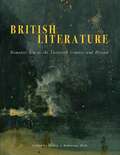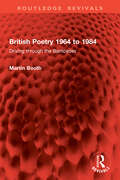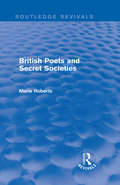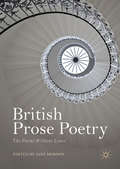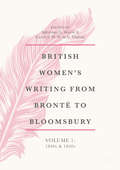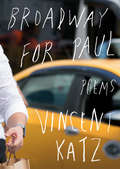- Table View
- List View
Bride of Ice: New Selected Poems
by Elaine Feinstein Marina TsvetaevaIntensely emotional and honest, this collection of searing poems about love, loss, jealousy, and fear, explores the literary and social landscape of post revolutionary Russia. Sharply addressing the conflicts between the life of a poet and that of a mother and wife, this enlarged volume, masterfully translated, includes five major poem sequences, one of which was written in 1915 for the poet's lover Sofia Parnok and another in response to poet Rainer Maria Rilke's death. Invoking Stalinist Russia as an underlying theme, this compilation also covers politics and history.
Bridestones (Hugh MacLennan Poetry Series)
by Miranda PearsonCome, anguish. Help us manage / the plainsong of an open shore, / its language of high tide rich and close, / close and hard to see.The early elegiac poems in Bridestones emerge from the borderlands between life and death, loss and renewal. Drawing on dreams, opera, and visual art, and employing symbolist and playfully surreal imagery, Miranda Pearson questions the ways we tend and grieve – for each other and our environment.Beginning with a sudden bereavement, the first section ends with a long poem, “Clearance,” that depicts the experience of emptying and departing a home – the physicality of a house serving as a vehicle for processing grief. Pearson writes on family trauma, illness, love, and desire with a pervading sense of hauntedness, compressed, lyrical accounts of complex and ambivalent terrain. The impact of a pandemic lurks in the background, and themes of fear run through much of this collection, with poems exploring how we face our fears – or deny and avoid them – and, ultimately, how we grow and adapt.Through meditations on art, myth, archaeology, ceremony, and death, Pearson reveals the veil between life and death when drawn to its thinnest. Like the hovering falcon depicted in “A Song of Roses,” the poems view the world from above: “if earth is body, and sky – God help us, spirit.”
Brief Homage to Pluto and Other Poems (The Lockert Library of Poetry in Translation #154)
by Fabio PusterlaAward-winning new translations of a major contemporary Italian poetBrief Homage to Pluto and Other Poems collects forty-five poems by Fabio Pusterla, one of the most distinguished Italian-language poets writing today. Born in Switzerland and resident in Italy, Pusterla engages the pressing moral concerns of his age and excavates the hidden realities of our concrete world. These are poems of disquieting Alpine landscapes and rift zones, filled with curious fauna, lanced with troubling memories, built “from the bottom, from the margins, from outside” the mainstream.Pusterla is the author of eight critically acclaimed books of poetry and has received several major literary prizes. Selected and translated by Will Schutt, himself an award-winning poet, this volume draws from Pusterla’s six most recent collections to capture a wide range of the poet’s work. With English translations and Italian originals on facing pages, Brief Homage to Pluto and Other Poems deftly introduces one of Europe’s most ambitious, imaginative, and humane poets to English-speaking readers.
Briefings: Poems Small And Easy
by A. R. AmmonsBriefings brings together more than eighty short lyrics that, as Harold Bloom writes, "maintain an utterly consistent purity of detached yet radiant vision." Bloom continues, "There are other American poets since Stevens who have composed a handful of memorable poems, but only Ammons has begun to show us a whole poetic world. More than his contemporaries, he has perfected a voice that, to cite Emerson, is 'ready to render an image of every created thing.'" David Kalstone says, "The poems are, by and large, tough or wry meditations, striking out into strange landscapes, dreams or nightmares, which are seen with entire clarity, no blurring, as if this were the only way the mind could be unwound on the page. The book forms a journal of mental states, each poem finding a form and a scene for a very exact mental encounter of discovery. . . . 'Small and Easy' is the way everything is finally made to seem, like the rarest dancing, in which briefly and freshly the dancer shows us what space is like by showing how much he can possess."
Bright Dead Things
by Ada Limón'Bright Dead Things buoyed me in this dismal year. I'm thankful for this collection, for its wisdom and generosity, for its insistence on holding tight to beauty even as we face disintegration and destruction.' Celeste Ng, author of Everything I Never Told You A book of bravado and introspection, of feminist swagger and harrowing loss, Bright Dead Things considers how we build our identities out of place and human contact - tracing in intimate detail the ways the speaker's sense of self both shifts and perseveres as she moves from New York City to rural Kentucky, loses a dear parent, ages past the capriciousness of youth and falls in love. In these extraordinary poems Ada Limón's heart becomes a 'huge beating genius machine' striving to embrace and understand the fullness of the present moment. 'I am beautiful. I am full of love. I am dying,' the poet writes. Building on the legacies of forebears such as Frank O'Hara, Sharon Olds and Mark Doty, Limón's work is consistently generous, accessible, and 'effortlessly lyrical' (New York Times) - though every observed moment feels complexly thought, felt and lived.
Bright Dead Things: Poems
by Ada Limón<P>Bright Dead Things examines the chaos that is life, the dangerous thrill of living in a world you know you have to leave one day, and the search to find something that is ultimately "disorderly, and marvelous, and ours." <P>A book of bravado and introspection, of 21st century feminist swagger and harrowing terror and loss, this fourth collection considers how we build our identities out of place and human contact-tracing in intimate detail the various ways the speaker's sense of self both shifts and perseveres as she moves from New York City to rural Kentucky, loses a dear parent, ages past the capriciousness of youth, and falls in love. Limón has often been a poet who wears her heart on her sleeve, but in these extraordinary poems that heart becomes a "huge beating genius machine" striving to embrace and understand the fullness of the present moment. "I am beautiful. I am full of love. I am dying," the poet writes. Building on the legacies of forebears such as Frank O'Hara, Sharon Olds, and Mark Doty, Limón's work is consistently generous and accessible-though every observed moment feels complexly thought, felt, and lived.
Bright Felon: Autobiography and Cities (Wesleyan Poetry Series)
by Kazim AliThis groundbreaking, transgenre work—part detective story, part literary memoir, part imagined past—is intensely autobiographical and confessional. Proceeding sentence by sentence, city by city, and backwards in time, poet and essayist Kazim Ali details the struggle of coming of age between cultures, overcoming personal and family strictures to talk about private affairs and secrets long held. The text is comprised of sentences that alternate in time, ranging from discursive essay to memoir to prose poetry. Art, history, politics, geography, love, sexuality, writing, and religion, and the role silence plays in each, are its interwoven themes. Bright Felon is literally "autobiography" because the text itself becomes a form of writing the life, revealing secrets, and then, amid the shards and fragments of experience, dealing with the aftermath of such revelations. Bright Felon offers a new and active form of autobiography alongside such texts as Theresa Hak Kyung Cha's Dictee, Lyn Hejinian's My Life, and Etel Adnan's In the Heart of the Heart of Another Country. A reader's companion is available at http://brightfelonreader.site.wesleyan.edu/
Bright Moon, White Clouds: Selected Poems of Li Po
by J. P. Seaton Li PoLi Po (701-762) is considered one of the greatest poets to live during the Tang dynasty--what was considered to be the golden age for Chinese poetry. He was also the first Chinese poet to become well known in the West, and he greatly influenced many American poets during the twentieth century. Calling himself the "God of Wine" and known to his patrons as a "fallen immortal," Li Po wrote with eloquence, vividness, and often playfulness, as he extols the joys of nature, wine, and the life of a wandering recluse. Li Po had a strong social conscience, and he struggled against the hard times of his age. He was inspired by the newly blossoming Zen Buddhism and merged it with the Taoism that he had studied all his life. Though Li Po's love of wine is legendary, the translator, J. P. Seaton, includes poems on a wide range of topics--friendship and love, political criticism, poems written to curry patronage, poems of the spirit--to offer a new interpretation of this giant of Chinese poetry. Seaton offers us a poet who learned hard lessons from a life lived hard and offered his readers these lessons as vivid, lively poetry--as relevant today as it was during the Tang dynasty. Over one thousand poems have been attributed to Li Po, many of them unpublished. This new collection includes poems not available in any other editions.
Bright Moves
by J. Allyn RosserBefore our overheated hearts cool off, We'll beat them back in shape to be recast In the mall of ever after for more true love, One thing we never thought we would need two of. From "Equitable Distribution". Annotation(c) 2003 Book News, Inc. , Portland, OR (booknews. com)
Bright Scythe: Selected Poems By Thomas Tranströmer
by David Wojahn Patty Crane Tomas TranströmerTomas Tranströmer (1931-2015), winner of the Nobel Prize for Literature, is Sweden's most acclaimed poet. Known for sharp imagery, startling metaphors and deceptively simple diction, his luminous poems offer mysterious glimpses into the deepest facets of humanity, often through the lens of the natural world. These new translations by Patty Crane, presented side by side with the original Swedish, are tautly rendered and elegantly cadenced. They are also deeply informed by Crane's personal relationship with the poet and his wife during the years she lived in Sweden, where she was afforded greater insight into the nuances of his poetics and the man himself.
Bright Star
by John KeatsJOHN KEATS edited with an introduction by Miriam Chalk This book gathers the most potent passages from Keats together, including the famous 'Odes', the sonnets, the luxuriously sensuous 'Eve of St Agnes', the mysterious and atmospheric 'La Belle Dame Sans Merci', and extracts from 'Lamia', Endymion and Hyperion. British Poets Series. Bibliography and notes. John Keats is one of the few British poets who is truly ecstatic and wild. Despite the overly-ornate language, the often awkward phrases ('made sweet moan' in 'La Belle Dame Sans Merci'), despite the Romantic indulgences and the sometimes sexist views, the often over-simplification of natural and human processes and experiences, and despite the tendency to gush and exaggerate, Keats is one of the few poets who write in English who is truly wild and shamanic. He is the British poet closest to the pure intoxication of Arthur Rimbaud. Keats reaches the pinnacle of British poetry, as W. Jackson Bate, typical among critics, says: 'the language of his greatest poetry has always held an attraction; for there we reach, if only for a brief while, a high plateau where in mastery of phrase he has few equals in English poetry, and only one obvious superior. '
Bright Star: The Complete Poems and Selected Letters
by John KeatsWITH AN INTRODUCTION BY DIRECTOR JANE CAMPIONJohn Keats died in penury and relative obscurity in 1821, aged only 25. He is now seen as one of the greatest English poets and a genius of the Romantic age. This collection, which contains all his most memorable works and a selection of his letters, is a feast for the senses, displaying Keats' gift for gorgeous imagery and sensuous language, his passionate devotion to beauty, as well as some of the most moving love poetry ever written.
Bright Stranger: Poems
by Katherine SoniatIn her beguiling new collection, Bright Stranger, Katherine Soniat invites the reader to celebrate the unfinished and unsure. The poems in this volume do not demand or offer certainty, existing instead in the spaces between the real and the imagined, between past and present and future. They explore the human connection to nature, contemplating loss in the erosion of rock spires and rebirth in the blossoming of an amaranth. Visually playful lines recall the poems' existence in the physical world, even as Soniat's words transport the reader from the rugged isolation of the Grand Canyon, to the elements within the periodic table, and on to "the unwinding spool of grey" in the mythic underworld of Hades. Bright Stranger offers a soaring vision of the world in all its chaos, bewilderment, and joy.
Brightness Falls from the Air
by James Tiptree Jr.Thousands of years in the future, a group of people assemble to witness the spectacular passing of the fiery front-wave caused by the nova of the Murdered Star.
Brilliance Is the Clothing I Wear (New Writing from InkWell Workshops #4)
by InkWell WorkshopsA diverse anthology of poetry, fiction, and creative non-fiction compiled from writers in the mental health and addiction communities.The latest in InkWell Workshops’ groundbreaking anthology series, this volume features poetry, fiction, and creative non-fiction from twenty-eight talented writers who are participants in the workshops. Led by accomplished professional writers with “unruly minds,” InkWell is a liberatory project that offers free creative opportunities to people with mental health and addiction issues. With themes of nourishment and desire, madness and connection, grief and hunger for a new world, these are fierce writings from the margins: honest, defiant, funny, and wise.
Bring Me The Rhinoceros: And Other Zen Koans That Will Save Your Life
by John TarrantBring Me the Rhinoceros is an unusual guide to happiness and a can opener for your thinking. For fifteen hundred years, Zen koans have been passed down through generations of masters, usually in private encounters between teacher and student. This book deftly retells more than a dozen traditional koans, which are partly paradoxical questions dangerous to your beliefs and partly treasure boxes of ancient wisdom. Koans show that you don't have to impress people or change into an improved, more polished version of yourself. Instead you can find happiness by unbuilding, unmaking, throwing overboard, and generally subverting unhappiness. John Tarrant brings the heart of the koan tradition out into the open, reminding us that the old wisdom remains as vital as ever, a deep resource available to anyone in any place or time.
Bring on the Birds
by Susan StockdaleBrightly colored, richly textured illustrations and an energetic rhyming text introduce young readers to birds and their unique qualities. Birds come in all sorts of interesting shapes, sizes, and colors—and many of them can do amazing things as well. From the Blue-footed Booby to the Red-billed Oxpecker, the breadth of bird life depicted in this stunning book will captivate young ornithologists. Susan Stockdale's bold colors and crisp, clean lines capture the reader's attention and introduce us to a remarkable world filled with distinctive creatures. An afterword identifies each animal and tells a little bit about it and where it lives.
Bringing Together: Uncollected Early Poems 1958-1989
by Maxine Kumin"The power that Kumin draws from and brings to literature is potent and seemingly inexhaustible."--Booklist Collected here for the first time, these early poems inhabit Kumin's own "sneakstorm time," a space one step to the side, where quiet introspection examines the pain of loss, the idealism of youth, and the endurance of the natural world. Her characteristic earthy wisdom snaps with intensity, offering a refreshing perspective on everyday experiences. "New England farm life, modern American history, Jewish identity and a quietly vibrant feminist consciousness provide themes for this gathering from a long and distinguished career."--Publishers Weekly.
Brink Road: Poems
by A. R. Ammons"No contemporary poet, in America, is likelier to become a classic than A. R. Ammons."—Harold Bloom With characteristic economy, A. R. Ammons writes that "Brink Road lies off NY 96 between Candor and Catatonk." The very name suggests that we are ever in transition from one state of mind to another always on the edge of revelation. The more than 150 poems in Brink Road date from 1973 to the present, dealing with Ammons's concerns with language, mortality, and the forces underlying the natural world. With elegance, wit, and ruminative gravity, Brink Road is an important addition to one of the most enduring bodies of poetry of our time.
British Literature: Romantic Era to the Twentieth Century and Beyond
by B J RobinsonThis open anthology of British Literature encompasses the following eras: Romantic, Victorian, and Twentieth Century and Beyond. The selections represent the literature developed and developing within and through their respective eras. Considering the limitations that the very act of anthologizing imposes, not all that could be representative is included. But what is included, hopefully, is literature that was shaped by its era and that helped shape the literature that followed. This anthology includes contextualizing Introductions to each era, Biographies of each author, and Reading and Review Questions on each author's included works. This material offers basic signposts toward critical interpretation and understanding of the selections. But they do not impose or intend to shape that understanding so students can instead hone their critical thinking skills and synthesize historical, cultural, and aesthetic concepts. With this open anthology, students can compare the selections both within and across historical eras to analyze shared themes. The theme of personal identity as inherent or as socially constructed opens a constellation of related themes, many of which students may take for granted or have not critically examined. Students can understand the revolutionary aspects of the Romantic era by considering how static and determined class distinctions of the eighteenth century became more fluid and conditional in the nineteenth century. They can understand how the Romantics, seeing past sources of identity within a stable class system catastrophically disrupted by revolutionary forces across Europe and ultimately within England, considered universal elements of individuality that were shared across all classes and that demonstrated fundamental equality among humans. Imagination became a touchstone of such shared humanity. Considering the theme of Imagination opens related themes of dream and nightmare, happiness and terror, truth and doubt (or self-truths and self-doubts). Categories of identity constructs--such as hero and monster--similarly become conditional or conditioned, for example, upon self-realization and social limitations. Students can consider how one era's literature influenced the next. Victorian poetry can suggest how revelation of self could be made objective and impersonal through dramatized monologues. A speaker's point of view can reveal truths about humanity--such as jealousy, control, hatred, and greed--that evoke both sympathy and rejection. Impersonality can then lead to the shifting impersonations of Modern literature. Ego and egotism can be deplored by Victorian writers but desired by the Moderns. The horrors of the twentieth century can subvert the heroics of the nineteenth. And the realization of these horrors can grow out of the very sense of individual rights that the Romantics expressed--rights shared across gender, race, and class. This anthology hopefully will open students (and readers) to the conversation that literature has held with readers in the past and is holding with us now.
British Poetry 1964 to 1984: Driving through the Barricades (Routledge Revivals)
by Martin BoothFirst published in 1985, British Poetry presents a personal and political account of British poetry from 1964 to 1984. Martin booth, himself a poet, poetry publisher, critic and editor, and the participant in poetry readings in Britain and overseas, shows that British poetry underwent a renaissance in the ten years from around 1964: poetry became a major popular art form, shaking off its shackles of elitism and academicism; poetry readings flourished, whether live or on the air and audiences increased; many new poets found willing publishers. He looks at the manner in which British poetry rose, only to fall back into a morbid sleek artiness where he sees it laying today, once again a narrow art for the literary educated and the initiated.The book aims to reverse this change of direction so that British poetry may once again have the impact it briefly had in its recent heyday. Martin Booth also provides a general guide to the period, with much comment included from those who were involved in the act of keeping British poetry going in those exciting years. He deals with the poets themselves, with the publishing of poetry, and poetry magazines, and his ‘non-literary’, ‘non-academic’ approach will appeal to all those who have an interest in modern British verse.
British Poets and Secret Societies (Routledge Revivals)
by Marie Mulvey-RobertsA surprisingly large number of English poets have either belonged to a secret society, or been strongly influenced by its tenets. One of the best known examples is Christopher Smart’s membership of the Freemasons, and the resulting influence of Masonic doctrines on A Song to David. However, many other poets have belonged to, or been influenced by not only the Freemasons, but the Rosicrucians, Gormogons and Hell-Fire Clubs. First published in 1986, this study concentrates on five major examples: Smart, Burns, William Blake, William Butler Yeats and Rudyard Kipling, as well as a number of other poets. Marie Roberts questions why so many poets have been powerfully attracted to the secret societies, and considers the effectiveness of poetry as a medium for conveying secret emblems and ritual. She shows how some poets believed that poetry would prove a hidden symbolic language in which to reveal great truths. The beliefs of these poets are as diverse as their practice, and this book sheds fascinating light on several major writers.
British Prose Poetry: The Poems Without Lines
by Jane MonsonThis book is the first collection of essays on the British prose poem. With essays by leading academics, critics and practitioners, the book traces the British prose poem’s unsettled history and reception in the UK as well as its recent popularity. The essays cover the nineteenth, twentieth and twenty-first centuries exploring why this form is particularly suited to the modern age and yet can still be problematic for publishers, booksellers and scholars. Refreshing perspectives are given on the Romantics, Modernists and Post-Modernists, among them Woolf, Beckett and Eliot as well as more recent poets like Seamus Heaney, Geoffrey Hill, Claudia Rankine, Jeremy Over and Vahni Capildeo. British Prose Poetry moves from a contextual overview of the genre’s early volatile and fluctuating status, through to crucial examples of prose poetry written by established Modernist, surrealist and contemporary writers. Key questions around boundaries are discussed more generally in terms of race, class and gender. The British prose poem’s international heritage, influences and influence are explored throughout as an intrinsic part of its current renaissance.
British Women's Writing from Brontë to Bloomsbury, Volume 1: 1840s and 1850s (British Women’s Writing from Brontë to Bloomsbury, 1840-1940 #1)
by Adrienne E. Gavin Carolyn W. de la L. OultonThis five-volume series, British Women’s Writing From Brontë to Bloomsbury, 1840-1940, historically contextualizes and traces developments in women’s fiction from 1840 to 1940. Critically assessing both canonical and lesser-known British women’s writing decade by decade, it redefines the landscape of women’s authorship across a century of dynamic social and cultural change. With each of its volumes devoted to two decades, the series is wide in scope but historically sharply defined. Volume 1: 1840s and 1850s inaugurates the series by historically and culturally contextualizing Victorian women’s writing distinctly within the 1840s and 1850s. Using a range of critical perspectives including political and literary history, feminist approaches, disability studies, and the history of reading, the volume’s 16 original essays consider such developments as the construction of a post-Romantic tradition, the politicization of the domestic sphere, and the development of crime and sensation writing. Centrally, it reassesses key mid-nineteenth-century female authors in the context in which they first published while also recovering neglected women writers who helped to shape the literary landscape of the 1840s and 1850s.
Broadway for Paul: Poems
by Vincent KatzFriendship, love, and the potential energy of change animate these poems of walking through New York City.Broadway, the famous artery, both off the grid and definitive of Manhattan as it cuts its way downtown, is a metaphor for Katz's path through these poems: from Lincoln Plaza on the Upper West Side to the African Burial Ground and the courthouses downtown, Katz mines his native city for the deep humanity that undergirds its streets. His title, with its implication that one could give something as large and undefinable as Broadway to a single person, courts an impossibility that generates the possibility of friendship, as well as the largesse Katz wants to find in our civic discourse. In poems such as "Ivanka Skirting" and "This Beautiful Bubble" we encounter his reckoning with a divisive culture that can, he suggests, be healed through our daily acts--through a kind of alert graciousness that also defines his poetry. In this moving collection, we enter Katz's world, both public and private, and experience poetry as a way of seeing that can change hearts and minds.
